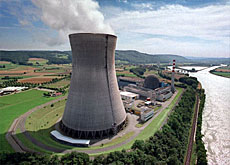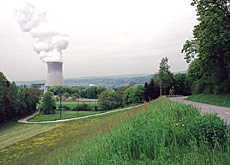Switzerland’s first nuclear plant decommissioned

The authorities have begun removing the last radioactive waste from the country’s oldest nuclear power station in Lucens, which was shut down after an accident in 1969.
Over the next fortnight, some 300 tons of material will be transported 160 kilometres to a temporary site in the north of the country.
“It’s the end of a historic chapter relating to the 1950s and 1960s, when nuclear stations were pioneered in our country,” the Swiss Association for Atomic Energy said in a statement on Wednesday.
Once all the radioactive material from Lucens in western Switzerland has been taken away in six steel containers, the reactor will be officially closed and the property handed over to the cantonal authorities.
Lucens – Switzerland’s first experimental nuclear station – opened in 1962. The plant, which was built in an underground cavern, produced electricity for the first time on January 29, 1968.
The aim of the project was not simply to provide energy, but to allow the country to develop a reactor bearing the “Made in Switzerland” label and to experiment with nuclear energy.
A generation of engineers, physicians, chemists and technicians helped to fine-tune operations in Lucens.
Nuclear energy
Switzerland established itself as a major developer of nuclear energy once the first commercial plants were opened in Beznau in 1969 and in Mühleberg in 1971.
But disaster struck the reactor on January 21, 1969. A pressure tube burst, creating a power surge, and the reactor malfunctioned. Some radioactive gas escaped from the cavern and the reactor had to be shut down.
The government ordered an inquiry into the incident and a report was eventually published ten years later.
The inquiry by the Swiss Association for Atomic Energy found there had been no major negligence on the part of the plant’s managers. It blamed the blast on a corroded pressure tube, which had been caused by humidity.
Security systems
The inquiry team said security systems had functioned as planned and neither the “staff nor the environment were exposed to dangerous levels of radiation”.
The plant’s cavern was partially filled with concrete in 1992.
Canton Vaud will shortly take over ownership of the property and will use the space to store cultural and archaeological goods.
In May the Swiss were asked to vote on the future of their nuclear industry.
They rejected one initiative to extend the existing moratorium on building new nuclear plants and another to close down the industry altogether.
There have been six different anti-nuclear proposals since 1979. Only one proved successful – in 1990 – which introduced a ten-year moratorium on the building of new plants.
swissinfo with agencies
Switzerland began its experiment with nuclear energy in 1957.
On April 30 that year, scientists succeeded in triggering an atomic reaction in the research reactor “Saphir” in Würenlingen, canton Aargau.
Switzerland then constructed its first nuclear plant in Lucens, canton Vaud, in 1962.
But it was forced to stop operations following an accident in 1969.
A second station, Beznau, was opened in 1969 and there are now five plants in operation across the country.
Forty per cent of Swiss energy is generated in its nuclear plants.
The Swiss have voted six times since 1979 on initiatives opposed to atomic energy, the last time in May 2003.

In compliance with the JTI standards
More: SWI swissinfo.ch certified by the Journalism Trust Initiative



You can find an overview of ongoing debates with our journalists here. Please join us!
If you want to start a conversation about a topic raised in this article or want to report factual errors, email us at english@swissinfo.ch.